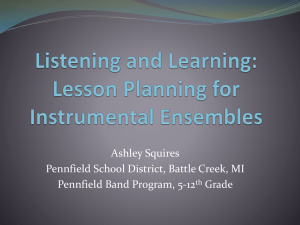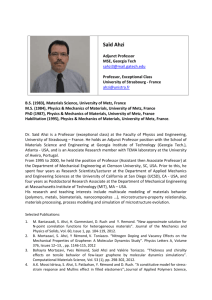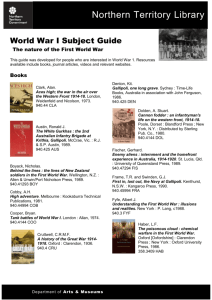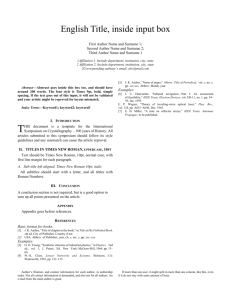Nature and Health Bibliography in MS Word
advertisement
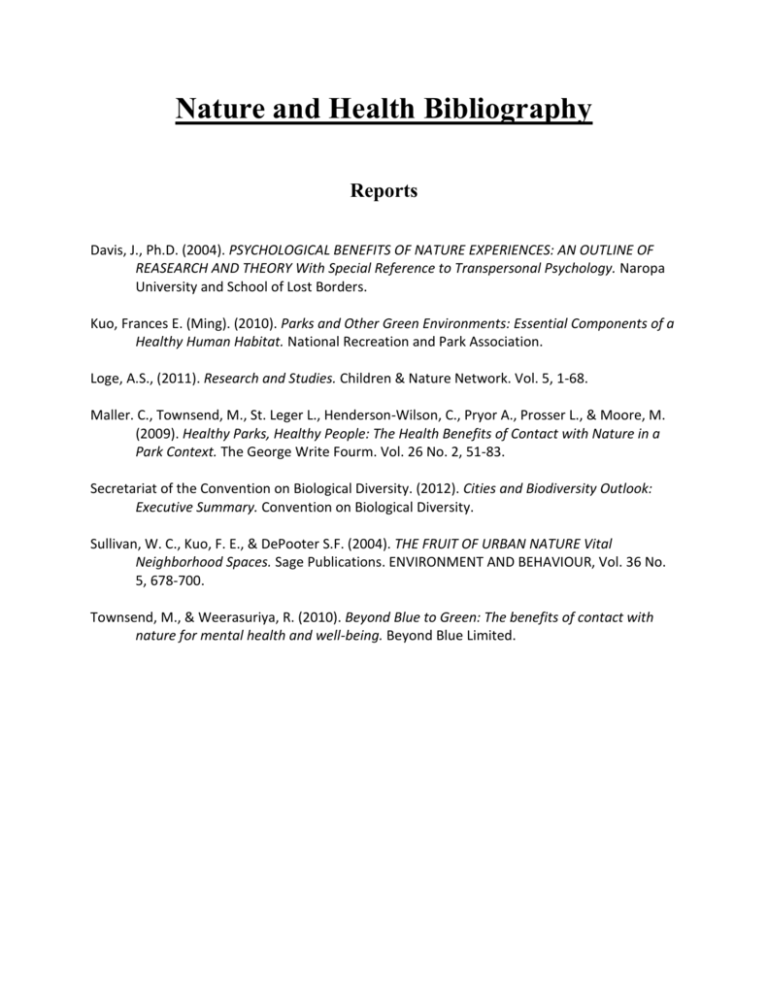
Nature and Health Bibliography Reports Davis, J., Ph.D. (2004). PSYCHOLOGICAL BENEFITS OF NATURE EXPERIENCES: AN OUTLINE OF REASEARCH AND THEORY With Special Reference to Transpersonal Psychology. Naropa University and School of Lost Borders. Kuo, Frances E. (Ming). (2010). Parks and Other Green Environments: Essential Components of a Healthy Human Habitat. National Recreation and Park Association. Loge, A.S., (2011). Research and Studies. Children & Nature Network. Vol. 5, 1-68. Maller. C., Townsend, M., St. Leger L., Henderson-Wilson, C., Pryor A., Prosser L., & Moore, M. (2009). Healthy Parks, Healthy People: The Health Benefits of Contact with Nature in a Park Context. The George Write Fourm. Vol. 26 No. 2, 51-83. Secretariat of the Convention on Biological Diversity. (2012). Cities and Biodiversity Outlook: Executive Summary. Convention on Biological Diversity. Sullivan, W. C., Kuo, F. E., & DePooter S.F. (2004). THE FRUIT OF URBAN NATURE Vital Neighborhood Spaces. Sage Publications. ENVIRONMENT AND BEHAVIOUR, Vol. 36 No. 5, 678-700. Townsend, M., & Weerasuriya, R. (2010). Beyond Blue to Green: The benefits of contact with nature for mental health and well-being. Beyond Blue Limited. Journals and Articles Bell J.F., PhD, MPH, Wilson, J. S., PhD, & Liu, G.C., MD, MS. (2008). Neighborhood Greeness and 2-Year Changes in Body Mass Index of Children and Youth. American Journal of Preventative Medicine. Berman, M.G., Jonides, J., & Kaplan, S. (2008). The Cognitive Benefits of Interacting With Nature. Psychological Science. Vol. 19 No. 12, 1207-1212. Bratman, G., Hamilton, P., Daily, G.C. (n.d.). The impacts of nature experience on human cognitive function and mental health. Annals of the New York Academy of Sciences ISSN 0077-892 Diette, G.B., MD, MHS, Lechtzin, N., MD, MHS, Hopnik, E. MD, FCCP, Devrotes, RN, & Rubin, H.R., MD, PhD. (2003). Distraction Therapy With Nature Sights and Sounds Reduces Pain During Flexible Bronchoscopy. Chest Journal, Vol. 123, 941-948. Foot. D., & Stoffman, D. (2000). Toronto that will be. Toronto Life Vol. 34 No. 1, 84-90. Frumkin H., MD, Dr. PH, FACP, FACOEM. (2001). Beyond Toxicity Human Health and the Natural Environment. American Journal of Preventative Medicine Vol. 20 No. 3, 234-240. Frumkin, H., & Louv, R. (2007). The Powerful Link Between Conserving Land and Preserving Health. Land Trust Alliance Special Anniversary Report. Hansen-Ketchum, P.A., & Halpenny, E.A. (2010). Engaging with nature to promote health: Bridging research silos to examine the evidence. Oxford University Press. Vol. 26 No. 1, 100-108. Korpela, K.M., Ylén, M., Tyrväinen, L., & Silvennoinen, H. (2010). Favorite green, waterside and urban environments, restorative experiences and perceived health in Finland. Oxford University Press, Vol. 25 No. 2, 200-209. Li. Q., (2009). Effect of forest bathing trips on human immune function. Environ Health Prev Med Vol. 15, 9-17. Lee, A.C.K., & Maheswara R. (2010). The health benefits of urban green spaces: a review of the evidence. Journal of Public Health, Vol.33 No. 2, 212-222. Louv, R. (2005). Nature Deficit. ORION. Maas, J., Verheij, R. A., Vries, S. de, Spreeuwenberg, P., Schellevis, F. G., & Groenewegen, P.P. (2008). Morbidity is related to a green living environment. J Epidemiol Community Health Vol. 63, 967-973. Maller, C., Townsend, M., Pryor, A., Brown, P., & St Leger, L. (2005). Healthy nature healthy people: ‘contact with nature’ as an upstream health promotion intervention for populations. Oxford University Press. Vol. 21 No.1, 45-54. Platt, J. (2013, January 17). Want to boost your creativity? Take a hike on the wild side, study suggests. The Hamilton Spectator. Living, pp. G7. Ryan, M. R., Weinstein, N., Bernstein, J., Brown, K.W., Mistretta, L., & Gagné, M. (2010). Vitalizing effects of being outdoors and in nature. Journal of Environmental Psychology. Vol. 30, 159-168. St Leger. L. (2003). Health and nature – new challenges for health promotion. Oxford University Press. Vol. 18 No. 3, 173-175. Taylor, A. F., Kuo, F. E.,& Sullivan, W.C. (2002). VIEWS OF NATURE AND SELF-DISCIPLINE: EVIDENCE FROM INNER CITY CHILDREN. Journal of Environmental Psychology Vol. 22, 49-63. Thompson, C. W., Roe, J., Aspinall, P., Mitchell, R., Clow, A., & Miller, D. (2012). More green space is linked to less stress in deprived communities: Evidence from salivary cortisol patterns. Landscape and Urban Planning Vol 105, 221-229. Unitt, L. (2009). Nature Deficit Disorder. The Wood Duck. Books Lewis, C.A. (1996). Green Nature/Human Nature: The Meaning of Plants in Our Lives Environment and the Human Condition. University of Illinois Press. Louv, R. (2005). Last Child in the Woods. Algonquin Books of Chapel Hill. Louv, R. (2011) Nature Principle. Human Restoration and the End of Nature-Deficit Disorder.v Algonquin Books of Chapel Hill. Williams, A (Editor). (2008). Therapeutic Landscapes. Ashgate Pub Co. Online Baycrest Centre for Geriatric Care. (2012, May 14). A walk in the park gives mental boost to people with depression. ScienceDaily. Retrieved September 16, 2014 from www.sciencedaily.com/releases/2012/05/120514134303.htm Bowler, et al. (2010). A systematic review of evidence for the added benefits to health of exposure to natural environments. BMC Public Health. Retrieved September 16, 2014 from http://www.biomedcentral.com/1471-2458/10/456 Gordon, A. (2011). Doctors write ‘park prescriptions’’ to get patients moving. The Hamilton Spectator. Retrieved September 16, 2014 from http://www.thespec.com/newsstory/2206679-doctors-write-park-prescriptions-to-get-patients-moving/ Kaplan, R. (2001). The Nature of the View from Home: Psychological Benefits. Environmental Design and Research Association. Retrieved September 16, 2014 from http://eab.sagepub.com/content/33/4/507 Russell, R., Guerry, A.D., Balvanera, P., Gould, R.K., Basurto, X., Chan, K.M.A, Klain, S., Levine, J. & Tam, J. (2013). Humans and Nature: How Knowing and Experiencing Nature Affect WellBeing. Annual Review of Environment and Resources Vol. 38: 473-502. Retrieved September 16, 2014 from http://www.annualreviews.org/doi/abs/10.1146/annurevenviron-012312-110838
